
|
![]()
Greatest Films of the 1930s
1930 | 1931 | 1932 | 1933 | 1934 | 1935 | 1936 | 1937 | 1938 | 1939
Title Screen Film Genre(s), Title, Year, (Country), Length, Director, Description 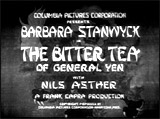


The Bitter Tea of General Yen (1933), 88 minutes, D: Frank Capra
A sophisticated, beautifully photographed film, considered non-PC, controversial and provocative at its time due to the inter-racial or cross-cultural romance in the plot. Strong-willed missionary Megan Davis (Barbara Stanwyck) from New England traveled to Shanghai, China in the 1930s, during a war-torn time of civil unrest. After joining her childhood sweetheart and chaste fiancee Dr. Robert 'Bob' Strike (Gavin Gordon), the betrothed couple became separated as they attempted to liberate an orphanage. Megan was taken prisoner (during rescue from a street riot) by ruthless and imposing Chinese warlord General Yen (Danish actor Nils Asther), who was assisted in his country stronghold by financial consultant Jones (Walter Connolly). Megan was presumed dead. To everyone's surprise, they developed an affectionate courtship and relationship, even though he had a mistress (also traitorous) - the lovely Mah-Li (Toshia Mori). However, their forbidden romance was threatened by invading Chinese rebels, and things came to a tragic, bitter end for the general.

Bombshell (1933), 90 minutes, D: Victor Fleming
A satirical, pre-Code farce with many inside jokes (and rapidly-paced dialogue) about Hollywood (a precursor to Sunset Blvd. (1950) and The Bad and the Beautiful (1952)), flappers and the hectic movie business - reportedly about star Clara Bow (director Fleming's ex-fiancee). Pampered movie sex symbol Lola Burns (Jean Harlow), the "bombshell" of the title, was thwarted by studio press agents and her demanding director - her divorced ex-lover Jim Brogan (Pat O'Brien), so she tried to get away by changing her locale and loose-living image. She escaped Hollywood for a desert hotel in Palm Springs, where she fell for wealthy Gifford Middleton (Franchot Tone), an upper-class effete snob, but left him too when her alcoholic father Pops Burns (Frank Morgan) was snubbed by his 'blue-blood' family. When she returned to the movie studio, she realized that her unscrupulous, unethical, manipulative and overbearing publicity director Space Hanlon (Lee Tracy) (who also loved her) had set her up, hiring Middleton and others in his "family" as impersonators, in order to get her to return to the movies and to him.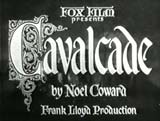

Cavalcade (1933), 110 minutes, D: Frank Lloyd
Fox's and director Frank Lloyd's over-produced film - a portent of other British costume drama award-winners in future years. The oft-forgotten Fox film, an adaptation based on Noel Coward's dramatic stage play (adapted by Reginald Berkeley), was honored with four nominations and three wins - Best Picture, Best Director, and Art Direction/Decoration. A big budget production, with epochal scenes and an anti-war attitude. The sweeping, episodic film, spanning over thirty years, featured an all-British cast (including Clive Brooks, Diana Wynyard, and young Frank Lawton) and traced the lives of the British upper-class Marryot turn-of-the-century family, from an 1899 New Year's Eve celebration around the time of the Boer War and the death of Queen Victoria through the sinking of the Titanic, World War I, the 1920s, the Depression, and up to a second New Year's Eve celebration in 1932. The effects of good and bad times and world events on the family's lives were chronicled (wartime, the death of the Queen, the husband's knighthood, the loss of one son on the Titanic and another in the Great War).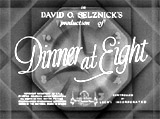



Dinner at Eight (1933), 113 minutes, D: George Cukor
A star packed, masterfully-directed classic MGM masterpiece - a witty, poignant romantic comedy-melodrama from 'woman's director' George Cukor and producer David O. Selznick. It was based on the popular, dialogue-rich Broadway hit by George S. Kaufman and Edna Ferber, and followed the successful pattern of MGM's previous year's Best Picture winner Grand Hotel (1932). It was studded with a tremendous ensemble cast of stars. The witty romantic comedy was filled with choice lines of dialogue, and revolved around various relationships between the characters before a dinner party party. A social-climbing, flighty Park Avenue snob Millicent Jordan (Billie Burke) was hosting a formal "dinner at eight" party in Manhattan during the height of the Depression, and invited an assortment of high-society guests. Vignettes and mini-episodes told the story, as cracks in the facade of the high-society members were beginning to emerge. Suicide, financial ruin, love, infidelity, economic pressures, class conflict, the dawn of the talkies, divorce, aging and fading careers, and alcoholism were all adversely affecting their interactions. From the time of the invitations to the actual party, she ignored the physical and financial struggles of her floundering businessman-husband Oliver Jordan (Lionel Barrymore). The invited guests included crass, crooked, rich tycoonish entrepreneur Dan Packard (Wallace Beery) and his candy-chewing, trampish, brassy blonde trophy wife Kitty (Jean Harlow) who often battled each other, the forgotten and aging ex-Broadway grand dame stage star Carlotta Vance (Marie Dressler), the cheating family physician Dr. Wayne Talbot (Edmund Lowe), and fading, suicidal, alcoholic silent-era matinee idol Larry Renault (John Barrymore).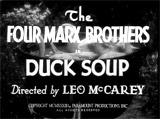



Duck Soup (1933), 70 minutes, D: Leo McCarey
An anarchistic, satirical, zany, anti-war film, one of the Marx Brothers' finest. Mrs. Teasdale (Margaret Dumont), wealthy millionaire supporter of the financially strapped, tiny country of Freedonia, decided to appoint a new president, dictatorial Rufus T. Firefly (Groucho). War clouds threatened almost immediately when Firefly insulted neighboring Sylvania's ambassador Trentino (Louis Calhern). Chicolini (Chico) and Brownie (Harpo) were hired as incompetent spies sent to get war plans. With classic diplomatic blunders, comic combat, terrific one-liners, slapstick gags, and great political humor.

Footlight Parade (1933), 104 minutes, D. Lloyd Bacon
One of the three most spectacular musicals in 1933 from Warner Bros. and legendary choreographer Busby Berkeley, alongside 42nd Street (1933) and Gold Diggers of 1933 (1933) - with this entry often considered the best of all three. The film was also notable for its suggestive pre-Hays Code dialogue and scenes. It starred James Cagney in his first, big singing-and-dancing musical role as unemployed yet enterprising Broadway theatrical producer Chester Kent, with Joan Blondell as his loyal secretary Nan Prescott. Its familiar plot, a backstage tale about putting on a lavish show, revolved around the production of live music numbers (called "prologues") for movie theatres to present before features, to give stage performers work who had been rendered unemployed by the advent of the "talkies." The thin plot was basically an excuse to show off the elaborate and extravagant Berkeley production numbers, especially the three showstoppers at the end of the film: "Honeymoon Hotel," "By a Waterfall" with gorgeous bathing beauties, and "Shanghai Lil" (providing commentary on Paramount's Shanghai Lily character (Marlene Dietrich in Shanghai Express (1932) from the year before)).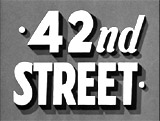


42nd Street (1933), 89 minutes, D: Lloyd Bacon
The quintessential backstage musical, a terrific song and dance Busby Berkeley choreographic extravaganza. Berkeley made screen history in this milestone-grandfather of spectacular musicals, with scores of chorus girls, large extravagant musical 'production numbers' and sumptuous art deco sets, surrealistic imagery, optical effects, zoom lenses, escapist musical numbers, fast-paced timing and rhythmic editing, and wise-cracking dialogue. The lively musical drama chronicled the hard work of a manic, ailing Broadway director Julian Marsh (Warner Baxter) behind the making of a musical comedy - where life (whether as a director or chorus girl) depended upon the success of the opening show. The Warner Bros.' 'putting on a show' film (with two Oscar nominations for Best Picture and Best Sound, with no wins) also featured two fresh new juvenile stars, Ruby Keeler (as a chorus girl) and tenor Dick Powell, and it starred Ginger Rogers as veteran showgirl Anytime Annie. Marsh was putting one last effort into a Broadway musical. But at the last minute right before opening night, it appeared doomed when the leading dancer Dorothy Brock (Bebe Daniels) broke her ankle. The show was saved when inexperienced chorus girl and understudy Peggy Sawyer (Keeler) dream is realized, and she was trained in a marathon rehearsal.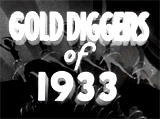

Gold Diggers of 1933 (1933), 96 minutes, D: Mervyn LeRoy
Mervyn LeRoy's blockbuster (a remake of the Gold Diggers of Broadway (1929) which itself was a remake of the silent film Gold Diggers (1923) about chorus girls), was a hugely-successful follow-up to Warners' 42nd Street (1933). It was one of choreographer Busby Berkeley's purest fantasies for the Depression Era, with spectacular numbers. The simple plot was the story of a Broadway show and intrigue surrounding its financial backing. It featured a young, coin-clad Ginger Rogers in the opening production number leading a chorus line of showgirls garbed in more gold-coin costumes singing "We're in the Money" (with one verse in Pig Latin). In another scene, Berkeley undressed his pretty chorus girls entirely behind screens, backlighting them so that the audience could see all they had to offer in silhouette. In another romantic scene "The Shadow Waltz," neon-lighted violins formed geometric designs on the screen with girls dressed all in white. The film ended with the social commentary of the finale's downbeat number: "Remember My Forgotten Man" accompanied by the singing of Joan Blondell - a tribute to unemployed WWI veterans.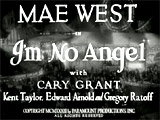

I'm No Angel (1933), 87 minutes, D: Wesley Ruggles
One of Mae West's funniest films (with lots of double entendres), and one of only two films in which West co-starred with Cary Grant. The star of a carnival side show act was dancer and lion tamer Tira (Mae West). When not performing, she fleeced many of her prospective suitors during numerous dalliances - she pursued playboy Jack Clayton (Cary Grant), but later the spurned Tira sued him for breach of promise. In the hilarious madcap courtroom scene that ended the film, he countered by assembling all her ex-lovers, but then allowed her to win the case.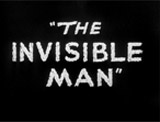

The Invisible Man (1933), 71 minutes, D: James Whale
H.G. Wells' novella tale, beautifully executed as a classic, Universal horror thriller. An obsessed mad scientist Jack Griffin (Claude Rains in his film debut) created a chemical formula compound that made him irreversibly invisible (with spectacular special effects), without any counter-agent. At first, the effects were comedic, but the serum slowly turned him into an insane megalomaniac lusting for power, and he wreaked havoc on a British country village.





King Kong (1933), 100 minutes, D: Merian C. Cooper
One of the greatest adventure and monster classics of all time, from RKO. Nature documentary filmmaker Carl Denham (Robert Armstrong) found destitute and beautiful Ann Darrow (Fay Wray) and hired her to join a chartered ship expedition to the mysterious and remote Skull Island. He discovered and captured a giant ape, King Kong (a marvel of stop-motion animation), using Ann as bait. The scenes between the blonde, screaming maiden and Kong bristled with fear and sexual overtones. A terrific scene included Kong's island battle with a Tyrannosaurus. Kong wais transported to New York City and put on display. Tormented by crowds, he escaped and created havoc in the city. After breaking free, Kong sought out Ann, and took her to the top of the Empire State Building in the thrilling climax.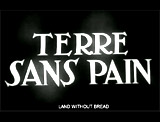

Land Without Bread (1933, Sp.) (aka Las Hurdes, or Terre Sans Pain), 28 minutes, D: Luis Buñuel
Filmed as a black and white travelogue with mordant narration. A short, landmark documentary film that was banned from being shown in Spain by the Spanish government from 1933-1936. Its subject matter was troubling - the impoverished conditions of around 6,000 indigent farming inhabitants in the NW coastal region of Spain (near Portugal) known as Las Hurdes, cut off by a massive mountain range. Poverty, lack of hygiene, pestilence, malnutrition of children and contaminated water sources were rampant, as were the crude and primitive houses.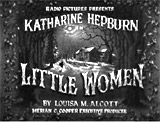

Little Women (1933), 117 minutes, D: George Cukor
Regarded as the best and most incomparable of all versions (also in 1949, 1978, and 1994), especially Katharine Hepburn as Jo. A delightful and faithful screen adaptation of Louisa May Alcott's classic American story of the teenaged March sisters and the sorrows and joys of the New England family. Father March had gone off to fight in the Civil War, so the family was left with four very independent sisters who were all coming of age, including an outstanding Katharine Hepburn as coltish tomboy Jo who wanted to be a writer. Each of the sisters found independence and strength, and some discovered romance.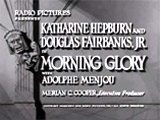

Morning Glory (1933), 74 minutes, D: Lowell Sherman
Adapted from a Zoe Atkins play, and remade by Sidney Lumet as Stage Struck (1958) with Susan Strasberg. A headstrong, starstruck, yet naive small-town girl from New England (Vermont), Eva Lovelace (Katharine Hepburn in her third film) wished to be a stage actress in the big city of New York, to make it big on Broadway. She showed incredible will and determination following disappointments, until she finally got her big break - after being recognized for a drunken Shakespearean soliloquy of the Romeo and Juliet balcony scene delivered at a cocktail party. She also became involved in a love triangle between Broadway manager Louis Easton (Adolphe Menjou) and playwright Joseph Sheridan (Douglas Fairbanks, Jr.). Whether her quick success would be long-lasting or withering like a "morning glory" remained to be seen. Hepburn's role paralleled her real-life career experience. Notable as the film in which Hepburn won her first Oscar for Best Actress (the first of four career Academy Awards).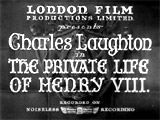




The Private Life of Henry VIII (1933, UK), 97 minutes, D: Alexander Korda
The well-known historical drama (or biopic), the chronicling of the life of the famous 16th century ruler, the eccentric, spoiled, despotic, corpulent, bawdy and much-married King Henry VIII (Charles Laughton), notoriously known for his gluttony scene and frequent beheading of his wives. The film centered on the succession of many wives, with a terrific performance by Elsa Lanchester (Laughton's real-life wife) as Henry's wily fourth wife, Anne of Cleves. Merle Oberon was on-screen briefly in the opening scene as Henry's second wife, Anne Boleyn, awaiting execution for alleged adultery. Boleyn was executed on the same day as King Henry's third marriage to Boleyn's maid Jane Seymour (Wendy Barrie) (who soon died in childbirth), while Henry already had his sights on Lady Katherine Howard (Binnie Barnes), an opportunist courtesan involved in a private affair with Henry's courtier Thomas Culpeper (Robert Donat). She eventually became his fifth wife.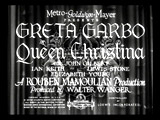



Queen Christina (1933), 97 minutes, D: Rouben Mamoulian
A classic, romantic, ethereal performance by Greta Garbo, in a lavish, well-produced costume-drama story that stretched historical truth - a story about the choice between love or duty. The lovely yet controversial 17th century (bisexual?) queen of Sweden, Queen Christina (Greta Garbo), rather than being forced into the possibility of a political marriage to military hero cousin Prince Charles (Reginald Owen) to give her country an heir to the throne, restlessly escaped the court dressed in a young man's clothes. She journeyed to a country inn during a snowstorm. She accidentally met and found love with the new Spanish (and Catholic) ambassador to Sweden, Don Antonio de la Prada (John Gilbert, Garbo's silent era leading man and lover). She revealed her true self and had a passionate love affair with him in their shared inn room. She shocked all of Europe by abdicating her throne for love, to follow Don Antonio to Spain. Unfortunately, ambitious and jealous courtier and ex-lover Count Magnus (Ian Keith) destroyed her dream by demonizing her lover. The final image of the film as she sailed away while standing pensively at the bow of the ship is most famous.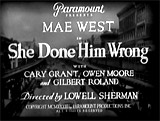

She Done Him Wrong (1933), 66 minutes, D: Lowell Sherman
A lusty Gay 90s spoof, with lots of clever innuendo, witty and irreverent one-liners, and bold carnality. The film deeply worried censorship officials and helped to speed the enforcement of the Code in the next year. Her main goals were to demolish the double standard, to be sexually frank, and to end prudery on screen. It was Mae West's star-making, most famous film role as a liberated, racy woman who enjoyed her sexuality. Buxom Mae West portrayed Bowery saloon owner and madame Diamond Lil. She romanced handsome and dashing Salvation Army mission director Captain Cummings (actually an undercover cop (Cary Grant)). Included West's singing of "Frankie and Johnny," "I Wonder Where My Easy Rider's Gone," and "I Like a Man What Takes His Time," and her most famous line of dialogue to the Captain: "Why don't you come up sometime 'n see me? I'm home every evening."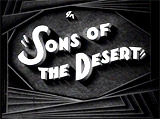

Sons of the Desert (1933), 68 minutes, D: William A. Seiter
A classic, hilarious comedy - the funniest full-length feature from Laurel and Hardy. The two boys Stan Laurel (Himself) and Oliver Hardy (Himself) deviously planned to fool their wives by claiming to have gone on a prescribed ocean voyage to Hawaii (to cure Ollie's illness), while instead attending the national convention of their fraternal Sons of the Desert lodge members in Chicago, with mad-cap conventioneer Charley Chase (Himself). Their plan failed miserably when the ship was reported sunk, and Mrs. Hardy (Busch) and Mrs. Laurel (Christy) discovered the truth, viewing their husbands in the fraternal parade in a movie newsreel. The pair had to explain why they had returned one day ahead of all the other survivors. In revenge, the two wives plotted to test their exposed mates.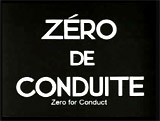


Zéro de Conduite: Jeunes Diables au Collège (1933, Fr.) (aka Zero For Conduct), 41 minutes, D: Jean Vigo
A satirical, semi-autobiographical film with slapstick banned by French censors until after WWII. The main characters were three rebellious students at a repressive French boarding school with authoritarian, corrupt, inept, and oppressive teachers (known as "monitors" or Surveillants), led by a long-bearded, tyrannical midget principal (Delphin). Only one new teacher was amusing - Huguet (Jean Dasté) - mimicking Charlie Chaplin and walking on his hands on his desk during class. "Zero for Conduct" grades and detention were often awarded to three students in particular: Bruel (Constantin Goldstein-Kehler), Caussat (Louis Lefebvre), and Colin (Gilbert Pruchon), joined by a fourth who proved himself - Tabard (Gerard de Bedarieux). They plotted to destroy the school during its annual Commemoration/Alumni Day celebrations, with a messy, slow-motion feather pillow fight in the dorm, a mock regal Catholic procession, and a liberating finale when the boys pelted teachers with debris from the rooftop (an inspiration for Lindsay Anderson's If... (1968)).